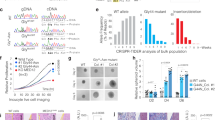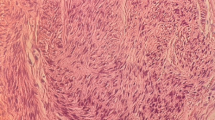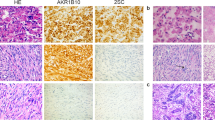Abstract
Uterine leiomyomas, or fibroids, are the most common human tumors. Based on histopathology, they can be divided into common leiomyomas and various relatively rare subtypes that mimic malignancy in one or more aspects. Recently, we showed that exon 2 of mediator complex subunit 12 (MED12) is mutated in up to 70% of common fibroids. To investigate the frequency of MED12 exon 2 mutations in histopathological uterine leiomyoma variants, we screened altogether 206 lesions, including 69 histopathologically common leiomyomas, 59 cellular (23 cellular and 36 highly cellular), 18 atypical and 26 mitotically active leiomyomas, as well as 34 uterine fibroid samples from 14 hereditary leiomyomatosis and renal cell cancer patients with a heterozygous germ line mutation in fumarate hydratase (FH). The uterine leiomyoma variants harbored MED12 exon 2 mutations significantly less frequently than common leiomyomas (P=2.93 × 10−8). In all, 6 mutations were detected among cellular fibroids (6/67; 8.96%), 3 among atypical fibroids (3/18; 16.67%) and 10 among mitotically active fibroids (10/26; 38.46%). Only mitotically active fibroids displayed a mutation frequency that was not statistically different from common leiomyomas (P=0.11). Three MED12 exon 2 mutations were detected among 34 tumors with a heterozygous germ line FH mutation (P=5.28 × 10−7). None of these tumors displayed biallelic inactivation of FH. Our results suggest that MED12 mutation positivity is a key characteristic of common leiomyomas. Cellular and atypical fibroids, in particular, may arise through different molecular mechanisms. The results also propose that MED12 and biallelic FH mutations may be mutually exclusive.
Similar content being viewed by others
Log in or create a free account to read this content
Gain free access to this article, as well as selected content from this journal and more on nature.com
or
References
Day Baird D, Dunson DB, Hill MC, Cousins D, Schectman JM : High cumulative incidence of uterine leiomyoma in black and white women: ultrasound evidence. Am J Obstet Gynecol 2003; 188: 100–107.
Stewart EA : Uterine fibroids. Lancet 2001; 357: 293–298.
Flynn M, Jamison M, Datta S, Myers E : Health care resource use for uterine fibroid tumors in the United States. Am J Obstet Gynecol 2006; 195: 955–964.
Hartmann KE, Birnbaum H, Ben-Hamadi R et al: Annual costs associated with diagnosis of uterine leiomyomata. Obstet Gynecol 2006; 108: 930–937.
Parker WH : Etiology, symptomatology, and diagnosis of uterine myomas. Fertil Steril 2007; 87: 725–736.
Hendrickson MR, Tavassoli FA, Kempson RL, McCluggage WG, Haller U, Kubik-Huch RA : Mesenchymal tumours and related lesions; in Tavassoli FA, Devilee P, (eds).: World Health Organization Classification of Tumours: Tumours of the Breast and Female Genital Organs. Lyon: IARC Press, 2003, pp 233–244.
Reed WB, Walker R, Horowitz R : Cutaneous leiomyomata with uterine leiomyomata. Acta Derm Venereol 1973; 53: 409–416.
Launonen V, Vierimaa O, Kiuru M et al: Inherited susceptibility to uterine leiomyomas and renal cell cancer. Proc Natl Acad Sci USA 2001; 98: 3387–3392.
Tomlinson IP, Alam NA, Rowan AJ et al: Germline mutations in FH predispose to dominantly inherited uterine fibroids, skin leiomyomata and papillary renal cell cancer. Nat Genet 2002; 30: 406–410.
Stewart L, Glenn GM, Stratton P et al: Association of germline mutations in the fumarate hydratase gene and uterine fibroids in women with hereditary leiomyomatosis and renal cell cancer. Arch Dermatol 2008; 144: 1584–1592.
Kiuru M, Lehtonen R, Arola J et al: Few FH mutations in sporadic counterparts of tumor types observed in hereditary leiomyomatosis and renal cell cancer families. Cancer Res 2002; 62: 4554–4557.
Lehtonen R, Kiuru M, Vanharanta S et al: Biallelic inactivation of fumarate hydratase (FH) occurs in nonsyndromic uterine leiomyomas but is rare in other tumors. Am J Pathol 2004; 164: 17–22.
Mäkinen N, Mehine M, Tolvanen J et al: MED12, the mediator complex subunit 12 gene, is mutated at high frequency in uterine leiomyomas. Science 2011; 334: 252–255.
Taatjes DJ : The human Mediator complex: a versatile, genome-wide regulator of transcription. Trends Biochem Sci 2010; 35: 315–322.
Knuesel MT, Meyer KD, Donner AJ, Espinosa JM, Taatjes DJ : The human CDK8 subcomplex is a histone kinase that requires Med12 for activity and can function independently of mediator. Mol Cell Biol 2009; 29: 650–661.
Kim S, Xu X, Hecht A, Boyer TG : Mediator is a transducer of Wnt/beta-catenin signaling. J Biol Chem 2006; 281: 14066–14075.
Lehtonen HJ, Kiuru M, Ylisaukko-Oja SK et al: Increased risk of cancer in patients with fumarate hydratase germline mutation. J Med Genet 2006; 43: 523–526.
Rozen S, Skaletsky H : Primer3 on the WWW for general users and for biologist programmers. Methods Mol Biol 2000; 132: 365–386.
Mäkinen N, Heinonen HR, Moore S, Tomlinson IP, van der Spuy ZM, Aaltonen LA : MED12 exon 2 mutations are common in uterine leiomyomas from South African patients. Oncotarget 2011; 2: 966–969.
Markowski DN, Bartnitzke S, Loning T, Drieschner N, Helmke BM, Bullerdiek J : MED12 mutations in uterine fibroids-their relationship to cytogenetic subgroups. Int J Cancer 2012; 131: 1528–1536.
McGuire MM, Yatsenko A, Hoffner L, Jones M, Surti U, Rajkovic A : Whole exome sequencing in a random sample of North American women with leiomyomas identifies MED12 mutations in majority of uterine leiomyomas. PLoS One 2012; 7: e33251.
Je EM, Kim MR, Min KO, Yoo NJ, Lee SH : Mutational analysis of MED12 exon 2 in uterine leiomyoma and other common tumors. Int J Cancer 2012; 131: E1044–E1047.
Perot G, Croce S, Ribeiro A et al: MED12 alterations in both human benign and malignant uterine soft tissue tumors. PLoS One 2012; 7: e40015.
Kämpjärvi K, Mäkinen N, Kilpivaara O et al: Somatic MED12 mutations in uterine leiomyosarcoma and colorectal cancer. Br J Cancer 2012; 107: 1761–1765.
Prayson RA, Hart WR : Mitotically active leiomyomas of the uterus. Am J Clin Pathol 1992; 97: 14–20.
Lehtonen HJ : Hereditary leiomyomatosis and renal cell cancer: update on clinical and molecular characteristics. Fam Cancer 2011; 10: 397–411.
Sanz-Ortega J, Vocke C, Stratton P, Linehan WM, Merino MJ : Morphologic and molecular characteristics of uterine leiomyomas in hereditary leiomyomatosis and renal cancer (HLRCC) syndrome. Am J Surg Pathol 2013; 37: 74–80.
Wei MH, Toure O, Glenn GM et al: Novel mutations in FH and expansion of the spectrum of phenotypes expressed in families with hereditary leiomyomatosis and renal cell cancer. J Med Genet 2006; 43: 18–27.
Sandberg AA : Updates on the cytogenetics and molecular genetics of bone and soft tissue tumors: leiomyoma. Cancer Genet Cytogenet 2005; 158: 1–26.
Tallini G, Vanni R, Manfioletti G et al: HMGI-C and HMGI(Y) immunoreactivity correlates with cytogenetic abnormalities in lipomas, pulmonary chondroid hamartomas, endometrial polyps, and uterine leiomyomas and is compatible with rearrangement of the HMGI-C and HMGI(Y) genes. Lab Invest 2000; 80: 359–369.
Gross KL, Neskey DM, Manchanda N et al: HMGA2 expression in uterine leiomyomata and myometrium: quantitative analysis and tissue culture studies. Genes Chromosomes Cancer 2003; 38: 68–79.
Acknowledgements
We thank Sini Nieminen, Inga-Lill Svedberg and Mairi Kuris for excellent technical assistance. This study was supported by the Academy of Finland (Center of Excellence in Cancer Genetics Research, grant 250345 and personal grant 260370 to PV), the Sigrid Jusélius Foundation, and the Cancer Society of Finland, as well as Emil Aaltonen Foundation, Orion-Farmos Research Foundation and K Albin Johansson Foundation (personal grants to NM).
Author information
Authors and Affiliations
Corresponding author
Ethics declarations
Competing interests
The authors declare no conflict of interest.
Additional information
Supplementary Information accompanies this paper on European Journal of Human Genetics website
Rights and permissions
About this article
Cite this article
Mäkinen, N., Vahteristo, P., Kämpjärvi, K. et al. MED12 exon 2 mutations in histopathological uterine leiomyoma variants. Eur J Hum Genet 21, 1300–1303 (2013). https://doi.org/10.1038/ejhg.2013.33
Received:
Revised:
Accepted:
Published:
Issue date:
DOI: https://doi.org/10.1038/ejhg.2013.33
Keywords
This article is cited by
-
Human Myometrial and Uterine Fibroid Stem Cell-Derived Organoids for Intervening the Pathophysiology of Uterine Fibroid
Reproductive Sciences (2022)
-
Uterine cellular leiomyomas are characterized by common HMGA2 aberrations, followed by chromosome 1p deletion and MED12 mutation: morphological, molecular, and immunohistochemical study of 52 cases
Virchows Archiv (2022)
-
Alterations in lipid profile upon uterine fibroids and its recurrence
Scientific Reports (2021)
-
Uterine Stem Cells and Benign Gynecological Disorders: Role in Pathobiology and Therapeutic Implications
Stem Cell Reviews and Reports (2021)
-
Leiomyoma with Bizarre Nuclei: a Study of 108 Cases Focusing on Clinicopathological Features, Morphology, and Fumarate Hydratase Alterations
Pathology & Oncology Research (2020)



